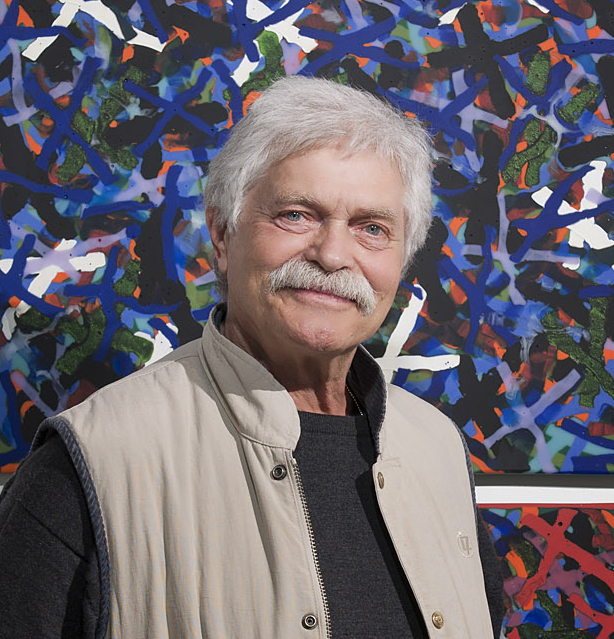
Klaus Moje talks with Paul Hollister about color in his work, purposely using a limited number of molds, and reworking a new piece in a 1982 interview at Pilchuck.
04:51Klaus Moje talks with Paul Hollister about color in his work, purposely using a limited number of molds, and reworking a new piece in a 1982 interview at Pilchuck. Interview with Klaus Moje by Paul Hollister, July 28, 1982. (Rakow title: Klaus Moje interview [sound recording] / with Paul M. Hollister, BIB ID: 168474). Clip length: 04:51.
Time stamp: 00:00
Clip 1: Klaus Moje talks with Paul Hollister about color in his work. Clip length: 02:20.
Paul Hollister (PH): Is that aventurine?
Klaus Moje (KM): That is aventurine—
PH: Green aventurine.
KM: Green aventurine, yeah.
PH: Beautiful.
KM: Yeah.
PH: Does this—
KM: This opens new possibilities to me—I would cut these through and I cut it crosswise—
PH: Uh-huh.
KM: —and after I have—
PH: Slices and—
KM: Sli— [inaudible] I put that together again, fuse them again—
PH: Make a plaid—
KM: Yeah.
PH: in the other direction.
KM: Yeah, yeah.
PH: They’re—is this the same kind of colors—
KM: No.
PH: —or are you buying them from somebody else?
KM: No, this—no this is a glass that is made in America that is Bullseye Glass which is made in Portland and—
PH: Portland, Oregon?
KM: —Portland, Oregon, and they have a color range of about fifty glasses which should be compatible, and you can really get compatible colors there if you buy the tested glass, so you can—
PH: The ones that are proven.
KM: Yeah, yeah.
PH: They’re not as pretty as your colors though—
KM: They—
PH: —your colors are more beautiful.
KM: Yeah, see if you see the colors are not cullet then they look awful too.
PH: Yeah.
KM: So after—after cutting they will show up.
PH: Yeah they look better.
KM: That’s—that’s very important.
PH: But this color—the—your color sense is wonderful, this color, and that color is absolutely beautiful and that color, and this. That—that satin—I love that.
KM: And after—after I know more about the palette of colors I get from—I can get from Bullseye I think there are many possibilities two of which are not proved up till now.
PH: That’s terrific that one. That is so simple, it’s like sea through the porthole and a ship. The sea and the sky.
KM: Yeah.
PH: Beautiful.
Time stamp: 02:23
Clip 2: Klaus Moje discusses using a limited number of molds in his work. Clip length: 01:19.
Klaus Moje (KM): I tried to be very, very simple and work with about five or six molds. And, okay I sat on different flats, different [inaudible] whichever, which were smaller or broader, but mainly I worked with about five molds. This mold, this mold is the same than this mold. This was a—this was a temp I made last year which was suppose—
Paul Hollister (PH): That’s interesting, yeah.
KM: But which also didn’t satisfy.
PH: Yeah. But it would be nice to see that polished down or flattened down, ground.
KM: Yeah [inaudible] kind of polish, it was an overlay of clear glass. [PH coughs] And in this case, I cut it down, small pieces of these colors instead [inaudible] in this way, the layers from this in that way and in this case in the vertical way.
PH: Yeah, yeah.
Time stamp: 03:45
Clip 3: Klaus Moje talks about reworking an unsuccessful piece. Clip length: 01:05.
Klaus Moje (KM): I’m—I’m not really happy with this piece here and—
Paul Hollister (PH): Oh, you mean the little patchy places?
KM: No, no I’m not—I’m not happy with the outer circle here. I have to review that. [inaudible]
PH: Could you—could you take a sheet that you’ve got made up and [inaudible] the different ways so that would go this way if I—the outline—the outline might be just like this might be the outline, but within that it would go a little bit this way and a little bit that way and then the lines go straight across or the pattern goes straight across—straight up and down, but you get a—
KM: —Yeah. If I went to remove the mold and then the lines will—will move with me.
PH: Yeah, a casual mold like that.
KM: —like his mold.
PH: Yeah, yeah. [William] Morris’s molds there where they’re not symmetrical or anything.